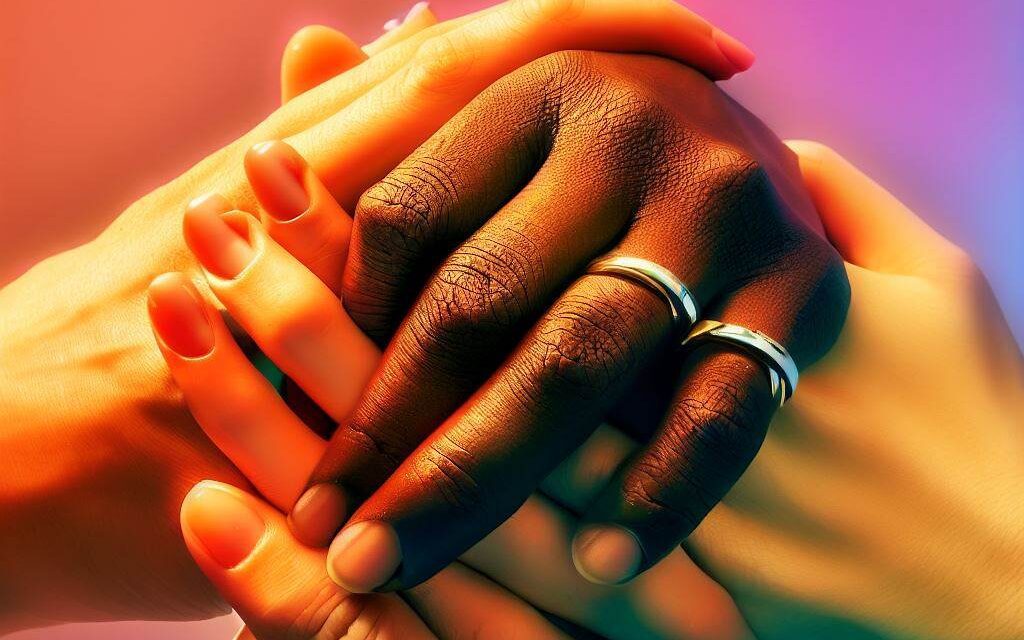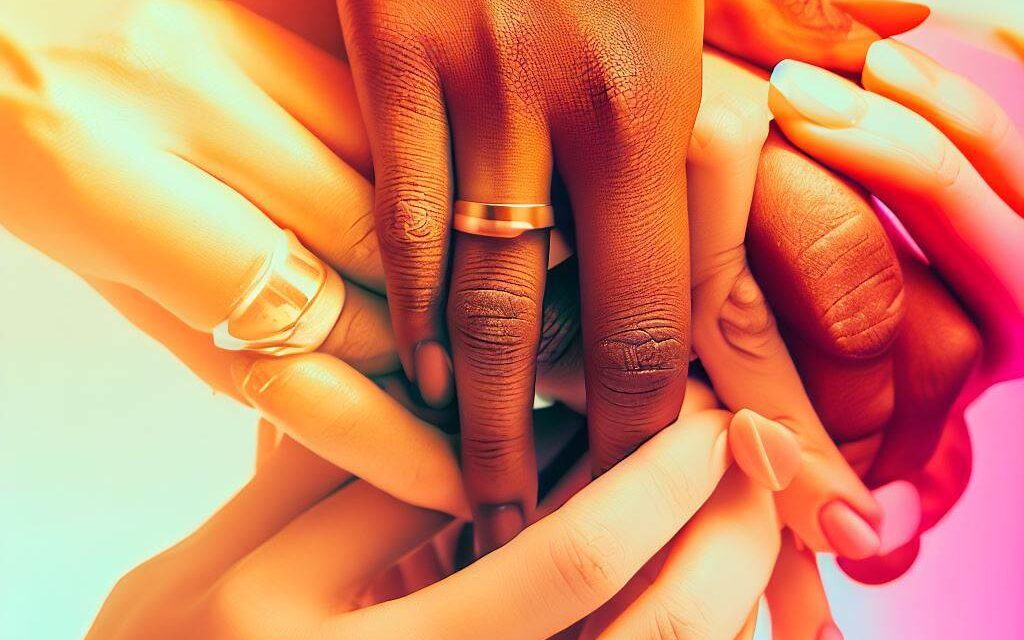Polyamory vs Polygamy
Posted on
Last updated
Posted on
Last updated
Polyamory and polygamy are two terms that are often used interchangeably, but they actually refer to different concepts. While both involve relationships with multiple partners, polyamory is based on the idea of informed consent from all parties involved, while polygamy typically involves one partner having multiple spouses.
In this article, we’ll discuss the differences between polyamory and polygamy in more detail. We’ll also look at how common these practices are today and explore whether either of them has any legal implications.
Polyamory is the practice of having romantic relationships with more than one partner, with the knowledge and consent of all parties involved. It involves open communication between partners to ensure that everyone’s needs are being met in an equitable way. In polyamorous family dynamics, ethical considerations around sexuality, cultural norms, and social roles become increasingly complex as more people are included in the relationship.
Polyamory often challenges traditional ideas about monogamy as well as societal expectations around marriage and nuclear families. Relationships take on different forms depending on those involved – they can be structured like a group marriage or involve multiple concurrent partnerships.
On the other hand, polygamy is the practice of having multiple spouses at once. This form of non-monogamy almost always involves only men taking additional wives, although there have been cases recorded where women have taken two husbands simultaneously.
Unlike polyamory which recognizes individual choice and autonomy for each partner involved, polygamy usually implies stricter gender roles and hierarchies within the relationship structure. It also tends to be rooted in religious beliefs rather than based on mutual respect or equal partnership among individuals.
With these differences in mind, it’s clear that both practices require careful consideration when it comes to personal decision making and understanding oneself within various contexts such as culture or religion. Moving forward into our next section we will explore a definition of polygamy further to gain a deeper understanding of this particular practice.

Polygamy is a marriage structure where two or more partners are involved in an exclusive, intimate relationship. It has become increasingly popular due to its ability to allow for multiple spouses, and the positive aspects of open communication and emotional connection it can provide.
In polygamy, trust dynamics within the family structure are often complex as all parties must agree upon boundary setting between each other. The benefits that come from these relationships vary depending on each individual’s needs and expectations but many find strength and comfort in having more than one partner available for support when needed.
While there may be some similarities between polyamory and polygamy, they have important differences that should not be overlooked. Moving forward, we will explore how their distinctions present themselves.
Although polyamory and polygamy may appear to have similar definitions, there are important distinctions between them. Both forms of non-monogamy involve multiple people who share a relationship together, but they differ in the types of relationships being established and how those involved approach ethical considerations.
Open communication and boundary setting are key elements when it comes to managing expectations or navigating religious views around sexuality and sexual health. Ultimately, understanding these subtle yet significant differences is essential for any person considering alternative relationship styles.
Polyamory and polygamy are two distinct relationship structures that have key differences in terms of their emotional complexity, gender roles, communication strategies, cultural norms, and overall relationship dynamics.
While both involve consensual relationships between multiple people, polyamory is based on an inclusive structure where all partners involved may know each other and choose to make decisions as a unit. Conversely, polygamy usually involves one main partner with several subservient partners who do not necessarily interact with or even know one another.
The fundamental difference lies in the fact that polyamory emphasizes mutual respect among all members within the arrangement while traditional polygamous unions tend to be more hierarchical and structured along rigid gender lines. This creates vastly different experiences for participants when it comes to communication strategies, how culture views these arrangements, and ultimately how they relate to one another over time.
To sum up, there are substantial discrepancies between polyamory and polygamy which stem from varying levels of emotional complexity, gender roles, communication approaches, cultural expectations, and overall relationship dynamics. Understanding these distinctions is essential for anyone considering entering into either type of union.
With this knowledge in hand then we can move onto exploring potential benefits associated with polyamorous relationships.
Polyamory is an often misunderstood concept, but it offers a unique opportunity to explore relationships in ways that traditional monogamy may not.
Navigating jealousy and emotional connection between multiple partners can be challenging, yet with the right communication strategies these issues can be managed.
Establishing relationship boundaries and balancing commitments are key when engaging in polyamorous relationships.
The benefits of polyamory are numerous – from developing deeper bonds with more than one person to having different kinds of support systems available as needed.
It also allows for greater self-discovery through exploring various dynamics within established partnerships which could lead to increased personal growth.
With careful consideration and clear communication, polyamory presents an alternative form of intimate partnership that enables individuals to develop meaningful connections beyond just one partner.
Allowing for such exploration opens up possibilities for new experiences and perspectives on life that simply aren’t possible with only one primary romantic partner.
Moving on, let’s take a look at the benefits of polygamy.

The benefits of polyamory are numerous, from open communication and trust building to emotional support. However, it is important to note that while there may be many advantages to living a polyamorous lifestyle, it comes with its own unique set of challenges.
One such challenge is family planning; establishing boundaries between partners in a polyamorous relationship can often require careful consideration and clear communication if the relationships are going to remain healthy. Additionally, managing multiple relationships can become overwhelming for some people who might not have the time or resources available to devote fully to each partner.
It’s essential for those considering entering into a polyamorous arrangement to understand both the potential benefits as well as any associated risks involved. Openly discussing expectations upfront with all parties involved and setting firm boundaries when necessary can help ensure everyone involved understands their individual roles within the dynamic.
Ultimately, understanding the full scope of what polyamory entails before taking part in this type of relationship can help create an environment where everyone feels respected and safe. With these considerations in mind, transitioning into exploring the challenges that come along with engaging in polyamory becomes easier.
Polyamory has its own unique set of challenges. These can include emotional complexity, communication difficulties, jealousy management, trust issues and conflict resolution.
Polyamory is often defined as being in a romantic relationship with more than one person at the same time – which comes with a lot of additional complexities when compared to monogamous relationships.
Every polyamorous relationship must find a way for all individuals involved to work through any difficult emotions such as jealousy, feelings of insecurity or possessiveness that arise from having multiple partners. Communication between all parties is essential for managing these complex dynamics.
It’s also important to establish rules and boundaries within the relationship so everyone knows what to expect from each other and cultivate strong levels of trust between them all. Conflict resolution skills are also necessary for navigating disputes around expectations or misunderstandings that may occur due to this type of arrangement.
Although it requires extra effort and understanding, many people believe that healthy polyamorous relationships have immense potential for growth and connection amongst their members. Despite the added difficulty, the rewards can be great if handled delicately and openly by all involved.
Moving on then, we turn our attention toward examining the challenges of polygamy…
The complexity of polygamy can be daunting. Not only does it require emotional intelligence and communication skills, but also financial planning, strong family relationships, and an understanding of relationship dynamics.
Everyone involved must feel valued for their individual contributions to the polyamorous unit in order for the system to work.
It is important to recognize that while both polygamous unions and polyamorous arrangements have many similarities, they are not one and the same.
That said, exploring the legal considerations between them provides a helpful insight into how each type of union may function in practice.
As we move forward, let us consider what implications exist when considering these two distinct yet related forms of non-monogamy.
While the terms polyamory and polygamy are often used interchangeably, there are some important distinctions between them. From legal ramifications to social stigmas, understanding these differences can be critical in determining what kinds of amorous relationships are permissible in certain areas.
In this section we’ll take a look at the different considerations that need to be taken when it comes to gender roles, consent issues, and more with regards to both forms of relationship structure.
When it comes to legal matters, having multiple partners is illegal for married couples in many countries around the world due to their interpretation of marriage as being limited only one man and one woman – which leads us into the discussion about gender roles.
Polygamy has been traditionally seen as an arrangement where men have multiple wives while women do not have the same rights; however, this is beginning to change with newer laws recognizing equal rights within such unions. On the other hand, polyamory takes a far less traditional approach regarding gender roles by allowing romantic relationships among all genders without any limitations or expectations imposed upon them by society.
Additionally, it’s essential to consider consent when discussing either type of relationship structures; each person involved should give explicit permission before entering into any type of agreement so that everyone feels comfortable and secure in their respective positions.
As can be seen from our examination here today, there certainly exist significant differences between polyamory and polygamy that must be taken into account before making any decisions about what kind of relationship works best for you.
Understanding these nuances allows individuals greater freedom over how they choose to express themselves within intimate settings regardless of external pressures or societal expectations.
It’s time now to move onto exploring how social acceptance plays its part…

Polyamory and polygamy are both relationship structures that involve more than two people. While the terms may be used interchangeably, they have distinct differences in their approaches to relationships.
Polygamy is a form of marriage where one partner has multiple spouses while polyamory involves having intimate relationships with more than one person at a time but not necessarily being married to them.
Cultural views on these practices vary greatly around the world and even within different social circles. In many instances, societies view polygamy as an accepted practice while polyamory is largely frowned upon. This discrepancy can place stress on those involved when it comes to deciding which structure works best for them or how open to be about their lifestyle choice.
To avoid potential judgement from family members or friends, communication strategies must be developed so all parties understand the expectations and limitations of the relationship dynamics. Furthermore, societal pressures can create emotional implications such as guilt, fear, or self-doubt if engaging in either type of relationship structure goes against what’s socially considered ‘normal’.
The importance of honesty and trust cannot be overstated in order to ensure everyone feels respected and secure in their chosen arrangement. Ultimately, it is up to each individual to decide what works best for them without letting external influences define their choices.
I need to decide for myself which form of relationship is best for me.
I can be sure that society will have opinions about my choices, but ultimately it comes down to what works for me and my partners.
If polyamory or polygamy could provide a loving, positive environment in our relationships, then I’m willing to give it a try.
Ultimately, I must weigh the pros and cons carefully before making any decisions, as the implications of both forms of relationships are significant.
Some links below may be affiliate links. As an Amazon Associate I earn from qualifying purchases.
These five resources can be a great starting point for anyone looking to learn more about non-monogamous relationships. From books like "Opening Up" and "More Than Two" that offer a deep dive into the emotional and ethical considerations of polyamory, to "The Lifestyle" by Terry Gould, which explores the motivations and experiences of swingers and their partners, there is something for everyone in this list. Whether you are interested in exploring non-monogamy yourself or simply want to learn more about these lifestyles, these resources can provide valuable insights and perspectives.
Using these resources can provide a well-rounded and informative comparison of polyamory and swinging, whether you're looking to explore non-monogamy yourself or simply want to learn more about these lifestyles.